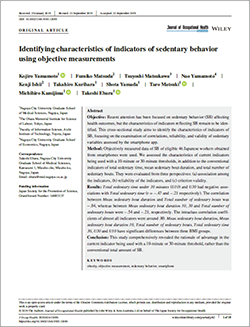#0004 Measuring the Measures of Sedentary Behavior: Are We Doing it Right?

Sedentary behavior as a risk factor for general health
There is much evidence suggesting that excessive sedentary behavior increases the risks of developing chronic ailments, such as cardiovascular diseases, and mortality. Many studies have also found links between sedentary behavior and high body mass index, metabolic syndromes, and increased waist circumference. However, several other studies have reported not finding such associations. The causes of these inconsistencies could be the indicators used for measuring sedentary behavior and the manner in which they are defined.
The conventional indicators of sedentary behavior are total sedentary time, average duration of sedentary bouts, and total number of sedentary bouts. In addition, researchers have recently begun to use minimum thresholds of 10 and 30 minutes to define what constitutes a sedentary bout. Unfortunately, it is not clear how valid and reliable these indicators are.
To shed light on this problem, we leveraged the power and ubiquitousness of smartphones to measure the sedentary behavioral patterns of 200 participants in a cross-sectional study. Using a motion logger app over a period of seven days, as well as questionnaires about daily activities every morning and evening, we gathered enough data to statically analyze and compare the different types of indicators of sedentary behavior.
Make sure to use a 10-minute minimum threshold for defining sedentary bouts
Our results suggest that using a 10-minute minimum threshold to define sedentary bouts represents prolonged sedentary patterns more reliably. In addition, total sedentary time, a widely used and traditional indicator, has poor statistical power compared with the more recently adopted indicators of 10- or 30-minute thresholds.
In addition to providing valuable and objective insights into indicators for measuring sedentary behavior, our study showcases how smartphones can be used as a powerful tool to measure sedentary behavior at even a community level.
Standardizing indicators is the first step in the process of scientifically and definitively establishing the risks associated with an excessively sedentary lifestyle, so that effective measures against it can be devised. This study should help researchers have the right variables handy for future works in this field.
Link to the original journal article:
https://onlinelibrary.wiley.com/doi/full/10.1002/1348-9585.12089
Title of this article:
Identifying characteristics of indicators of sedentary behavior using objective measurements
Authors:
Kojiro Yamamoto, Fumiko Matsuda, Tsuyoshi Matsukawa, Nao Yamamoto, Kenji Ishii, Takahiro Kurihara, Shota Yamada, Taro Matsuki, Michihiro Kamijima, Takeshi Ebara





